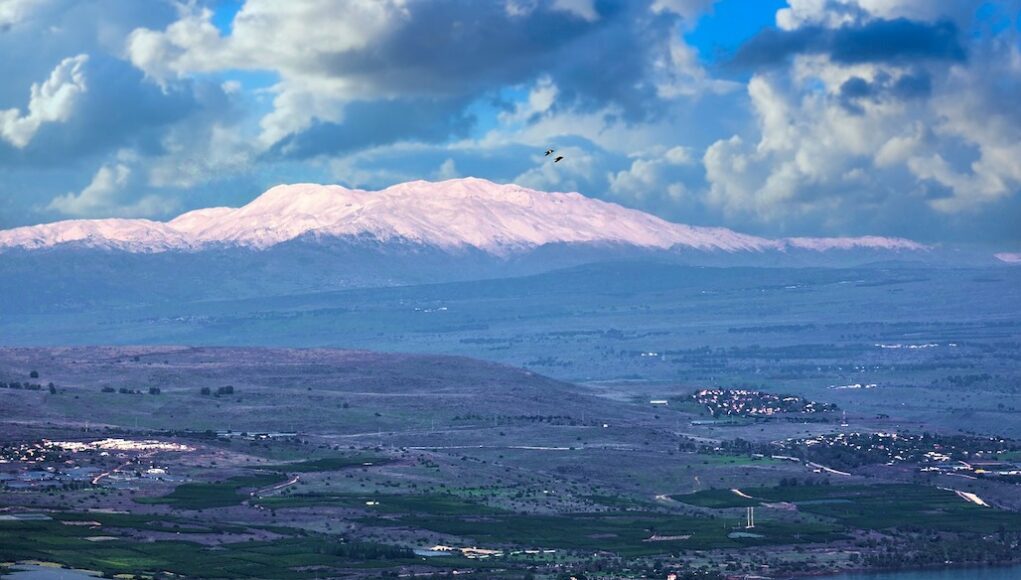BACKGROUND, ARCHAEOLOGY, AND SIGNIFICANCE
The view is breathtaking! This lofty mountain, stretching for a distance of 30 miles, has several peaks. It looks more like a mountain range than a single mountain from a distance. The highest point is on the southwest side and is most visible as you approach it from the Sea of Galilee.
The fertile fields below Hermon set off the white, snow-capped peaks. Skiers enjoy these slopes in the winter and spring with lifts and winter sports facilities at Newe Ativ. The mountain’s lower slopes are known for orchards of apples, plums, cherries, pears, almonds, and a pine forest. The bounty of God’s goodness can be seen all around Mount Hermon; it is no wonder the Psalmists saw this as a significant site.
The summit of Mount Hermon rises to an elevation of over 9,200 feet, dominating the landscape of northern Israel. The limestone mountain has steep slopes on its eastern side, but the stepped terraces on its western side receive more dew, rain, and snow.
The groundwater from Mount Hermon and the runoff from the melting snow from the headwaters of the Jordan River. Historically, this lush area was teeming with wildlife, even King Solomon writes about it:
Come with me from Lebanon, my bride, come with me from Lebanon. Descend from the crest of Amana, from the top of Senir, the summit of Hermon, from the lions’ dens and the mountain haunts of the leopards. SONG OF SOLOMON 4:8
From the summit of Mount Hermon on a clear day, the view to the south includes the mountains of Gilead, the Huleh Valley, the Sea of Galilee, and the Jordan Valley beyond. When looking toward the east, you can see the plain extending all the way to Damascus. The view toward the west includes the mountains of Upper Galilee, Mount Carmel, the Mediterranean coast, and the mountains of Lebanon. Looking north from the peak, the rest of the Eastern Lebanon mountain range fills the skyline.
MOUNT HERMON IN HISTORY
Mount Hermon was considered the northern border of the territory conquered by Joshua. It was allotted to half of the tribe of Manasseh (1 Chronicles 5:23), but the history of the mountain goes back much further. The Egyptians knew it as Sirion. The Amorites, as well as later Assyrian conquerors, called it Mount Senir (Ezekiel 27:5). The name Mount Hermon comes from the Hebrew root word meaning “taboo” or “consecrated.” Archaeologists have found numerous cultic areas attesting to the religious use of the mountain throughout the first millennium B.C.
In the second century B.C., an Arab tribe, known as the Itureans, migrated into the Huleh Valley and onto the slopes of Mount Hermon. When the area came under Roman control, Mark Antony gave the area to Cleopatra as a gift. After the death of the ill-fated couple, Caesar Augustus gave the land to Herod the Great, with the responsibility of clearing the area of bandits who preyed on travelers. The defeated Itureans, who had used the natural strongholds of the mountain slopes as hideaways, were recruited into the Roman army. They had an excellent reputation as archers.
THE ARCHAEOLOGY OF MOUNT HERMON
Several groups of people considered Mount Hermon a sacred place over the centuries. Archaeologists have surveyed over twenty temples and sacred enclosures on the mountain. Many of the sites appear to be Canaanite or Phoenician cult centers dedicated to Baal.
Later, in the two centuries before Christ, niches and grottos were cut into the rock at these sacred areas, similar to those at Caesarea Philippi. Beginning in the first century A.D., temples were built in a Greco-Roman style, even though the people worshiping there were Itureans.
MOUNT HERMON IN THE BIBLE
Mount Hermon formed a natural barrier between Israel and Syria in the Old Testament. The area around Mount Hermon belonged to the half-tribe of Manasseh, who lived east of the Jordan River. Although no significant events in the Old Testament are recorded to have happened here, it is mentioned for its abundant water, wood, and wildlife.
Herod the Great controlled the area around Mount Hermon in the New Testament era until his death in 4 B.C., and then ownership was passed to his son Herod Philip II (Luke 3:1).
Some scholars believe Mount Hermon is a possible location for Christ’s transfiguration. The main basis for this assumption is that the context of the event, given in Matthew 16:13 and 17:1, is near Caesarea Philippi. If the transfiguration did happen in the same area, then the nearest “high mountain” is Mount Hermon. The other possible location is Mount Tabor, which is a two-day walk from the base of Mount Hermon. I tend to believe Mount Tabor is likelier, but the debate over the location is ongoing. It may be unlikely that Christ and His disciples climbed this elevation. The story following a demon-possessed man makes more sense in the setting of Mount Tabor.
SO WHAT CAN WE LEARN FROM MOUNT HERMON?
Behold, how good and pleasant it is when brothers dwell in unity! It is like the precious oil on the head, running down on the beard, on the beard of Aaron, running down on the collar of his robes! It is like the dew of Hermon, which falls on the mountains of Zion! For there the Lord has commanded the blessing, life forevermore. PSALM 133
Lofty Mount Hermon, towering more than 9,000 feet above sea level, is beautiful with its year-round snow-capped peaks. Without Mount Hermon, Israel would be a desert wasteland. Nearly all the water in the country comes from this mountain. Moisture blowing in from the Mediterranean Sea forms clouds around this towering peak, causing rain and snow to fall upon Northern Israel. The resulting precipitation and runoff from the mountain is the water source for the Sea of Galilee and the Jordan River.
Meanwhile, Jerusalem and its surrounding hills farther south are on the edge of the desert. They depend on local rain showers for water. However, what if the abundant waters of Mount Hermon in the north could somehow be poured out on Jerusalem? Psalm 133 envisions a fantastic scene of the moisture of Mount Hermon falling directly on the mountains around Jerusalem. If this were possible, the mountains of Zion would see growth, and the unproductive desert would be transformed into fertile farmland.
According to the psalmist, this picture of unimaginable blessing reflects what it would be like if brothers could live together in unity. The benefits of unity would be poured out upon the people of God, transforming their lives from a meager spiritual existence to lives of great blessing.
How sincere are we in our desire for harmony with others? When there is unity among people, the blessing of God comes to the world (John 17:20- 26). Just as this majestic mountain gives life to the land of Israel, so our pursuit of peace among men blesses the world and gives the love of Christ to those who desperately need it. Jesus prayed for the blessings of unity to be poured out upon His people, on His disciples, and on all believers:
“I do not ask for these only, but also for those who will believe in Me through their word, that they may all be one, just as You, Father, are in Me, and I in You, that they also may be in us, so that the world may believe that You have sent Me. The glory that You have given Me I have given to them, that they may be one even as we are One, I in them and You in Me, that they may become perfectly one, so that the world may know that You sent Me and loved them even as You loved Me.” JOHN 17:20–23, ESV







![Where is God when Discouragement Sets In? [Sermon]](https://joshweidmann.com/wp-content/uploads/2022/06/paola-chaaya-eAkjzXCU0p0-unsplash-180x135.jpg)

![How to Help Kids with Anxiety [video]](https://joshweidmann.com/wp-content/uploads/2020/07/mladen-borisov-RzbUUaP2JXY-unsplash-180x135.jpg)




